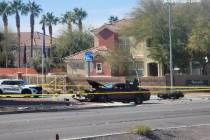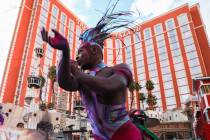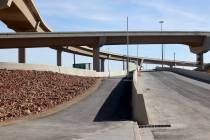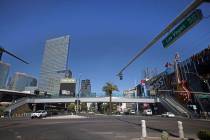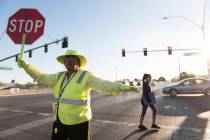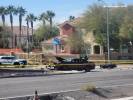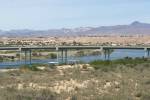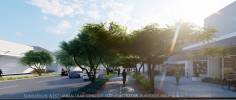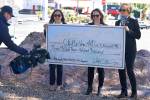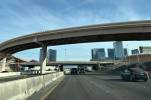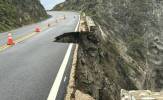Here’s the skinny: Narrower streets may improve traffic
Imagine building a beautiful custom home only to top it off with a front porch blanketed with green artificial turf.
Somehow that is what comes to mind after seeing the Regional Transportation Commission's latest efforts to protect nonmotorized commuters from motorists -- a bike lane covered with a green plastic film similar to crosswalk markings.
Apparently that is what is needed to get the attention of those who drive vehicles, those who aren't accustomed to seeing or who really don't care about others who choose to walk or ride their bikes. It's not only a byproduct of living in Las Vegas, it's a byproduct of how this community was developed.
Transportation experts are dedicated to changing motorists' mentalities. To do that, they must first change the mindset of roadway design engineers and residential developers.
"It's a change of culture," said Susan Martinovich, director of the Nevada Department of Transportation.
Evidence of the newer culture can be seen along Alta Drive and downtown, which will feature narrower roadways, attractive brick crosswalks and, well, green bike lanes. The "complete streets" design will also be applied to Sahara Avenue, which is in the midst of a face-lift that will rival the work on Joan Rivers.
The idea is to scrap the thought process that has dominated this town for the last five decades and move in a direction that appeases everyone. If you don't think there is a problem, take a look around. It is fairly obvious how antiquated designs place more vehicles on the road.
Neighborhoods are walled in with one or two access streets. So if a commercial center is a quarter-mile away from your home, by the time you find a way out of the neighborhood, an errand turns into a 1½-mile trek and you will be lucky if you are afforded a sidewalk. In the end, taking the car is more efficient.
Road designs that have been implemented since the 1950s also helped create this continuing clash between motorists and pedestrians or bicyclists.
Las Vegas streets discourage people from pursuing a healthier lifestyle by walking or pedaling to work or the store. Streets are wide and so are the lanes, which only encourages speeding and reckless driving.
According to the Regional Transportation Commission,
90 percent of pedestrian fatalities have occurred on arterials where the speed limit exceeds 35 mph.
"This information leads us to conclude the general public gives a higher priority to driving fast, rather than pedestrian safety," said Jacob Snow, who heads the transportation agency. "The demand of the public was to speed up traffic and move cars faster."
The new movement is toward creating an atmosphere seen in larger cities that maintain a small-town feel. So, is it possible to convert Las Vegas into a city like Portland, Ore.?
That is the intent of traffic experts from Henderson, North Las Vegas, Las Vegas and the county. And so like most of us following the holiday season, Snow is placing our streets on a strict diet. He wants them skinnier.
He points to Water Street in Henderson, which was narrowed to one lane in each direction to accommodate street parking, bicycle lanes, public transit and wider sidewalks for pedestrians.
Sahara will have special lanes for public transit and wider tree-lined medians with broader sidewalks. The arterial will also receive a high-intensity activated crosswalk (known as HAWK) signal at 15th Street. When pedestrians press the crosswalk button, overhead lights will flash yellow and turn to red.
All this work on major streets translates to fewer lanes.
While narrower streets will certainly slow traffic, having them may not mean it will take motorists longer to reach their destinations. Wait, does that make sense? Actually, yes, according to Snow. He said that it is easier to synchronize traffic signals because platoons of vehicles are generally traveling the same speed.
It also creates a safer environment for all residents.
A slower pace will allow motorists to make eye contact with pedestrians or bicyclists, generating more respect. As Snow puts it, these newer designs not only make the community more attractive, but "rehumanize" us.
It is understandable that we've lost some of our human side by being walled into our neighborhoods and using our middle fingers to communicate on our roadways. We've heard that diets make us healthier; we'll see if Snow's diet makes us happier.
If you have a question, tip or tirade, call Adrienne Packer at 702-387-2904, or send an email to roadwarrior@reviewjournal.com. Include your phone number.
■ For the next four weeks, expect major nighttime delays in the northbound lanes of the Airport Connector Tunnel as crews upgrade ceiling-mounted safety lights. Between 8 p.m. to 5 a.m., only one northbound lane will be open to traffic.
■ Through Dec. 20, expect intermittent detours as concrete is poured for a bridge that will carry traffic from the northbound tunnel to Terminal 3. The construction will occur during six evenings, but airport officials could not identify specific dates.
■ Through the end of February, expect delays on Tropicana Avenue at Valley View Boulevard because of a new sewer project. Left turns from Tropicana at the intersections and some businesses will be restricted intermittently. Lane restrictions also will be in place on Valley View at Tropicana.
■ Through Dec. 19, from 7 a.m. to 3:30 p.m., Lone Mountain Road will be reduced to one lane in each direction between Jones Boulevard and Torrey Pines Drive for a storm drain project.
GASOLINE PRICES
The average price of gasoline in the Las Vegas Valley on Friday was $3.36 per gallon; the current state average is $3.39; the national average is $3.29. Find the Las Vegas Valley's best deals at gasbuddy.com.
Las Vegas Review-Journal








